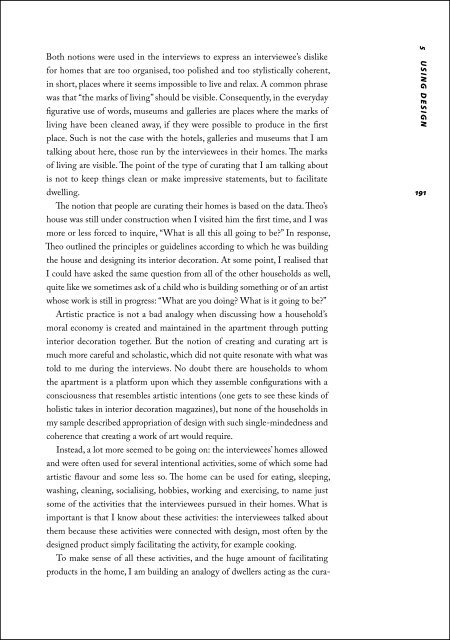Lataa ilmaiseksi
Lataa ilmaiseksi
Lataa ilmaiseksi
Create successful ePaper yourself
Turn your PDF publications into a flip-book with our unique Google optimized e-Paper software.
Both notions were used in the interviews to express an interviewee’s dislike<br />
for homes that are too organised, too polished and too stylistically coherent,<br />
in short, places where it seems impossible to live and relax. A common phrase<br />
was that “the marks of living” should be visible. Consequently, in the everyday<br />
figurative use of words, museums and galleries are places where the marks of<br />
living have been cleaned away, if they were possible to produce in the first<br />
place. Such is not the case with the hotels, galleries and museums that I am<br />
talking about here, those run by the interviewees in their homes. The marks<br />
of living are visible. The point of the type of curating that I am talking about<br />
is not to keep things clean or make impressive statements, but to facilitate<br />
dwelling.<br />
The notion that people are curating their homes is based on the data. Theo’s<br />
house was still under construction when I visited him the first time, and I was<br />
more or less forced to inquire, “What is all this all going to be?” In response,<br />
Theo outlined the principles or guidelines according to which he was building<br />
the house and designing its interior decoration. At some point, I realised that<br />
I could have asked the same question from all of the other households as well,<br />
quite like we sometimes ask of a child who is building something or of an artist<br />
whose work is still in progress: “What are you doing? What is it going to be?”<br />
Artistic practice is not a bad analogy when discussing how a household’s<br />
moral economy is created and maintained in the apartment through putting<br />
interior decoration together. But the notion of creating and curating art is<br />
much more careful and scholastic, which did not quite resonate with what was<br />
told to me during the interviews. No doubt there are households to whom<br />
the apartment is a platform upon which they assemble configurations with a<br />
consciousness that resembles artistic intentions (one gets to see these kinds of<br />
holistic takes in interior decoration magazines), but none of the households in<br />
my sample described appropriation of design with such single-mindedness and<br />
coherence that creating a work of art would require.<br />
Instead, a lot more seemed to be going on: the interviewees’ homes allowed<br />
and were often used for several intentional activities, some of which some had<br />
artistic flavour and some less so. The home can be used for eating, sleeping,<br />
washing, cleaning, socialising, hobbies, working and exercising, to name just<br />
some of the activities that the interviewees pursued in their homes. What is<br />
important is that I know about these activities: the interviewees talked about<br />
them because these activities were connected with design, most often by the<br />
designed product simply facilitating the activity, for example cooking.<br />
To make sense of all these activities, and the huge amount of facilitating<br />
products in the home, I am building an analogy of dwellers acting as the cura-<br />
5 U S I N G D E S I G N<br />
191
















